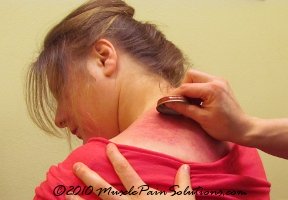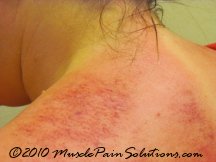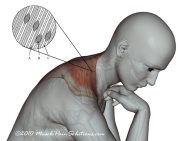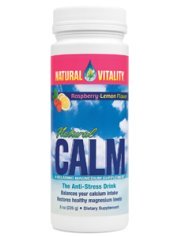Breaking Up Scar Tissue and Muscle Adhesions with Gua Sha
In chiropractic school, I had a classmate who was familiar with Chinese folk medicine. He taught us that Gua Sha was a great modality for breaking up scar tissue. Gua Sha (pronounced gwa shaw) has been widely practiced by the general populace in China (and other Asian countries) since prehistoric times, and only more recently been adopted by professional healthcare providers.
What is Gua Sha?
Gua Sha is an Eastern Asian healing technique used to treat colds, flu, stasis of chi, sluggishness, migraines, poor circulation, etc. as well as aching and tenderness in the muscles. Gua means to scrape or rub. Sha is a reddish skin rash with petechiae (looks like tiny blood spots) raised by the rubbing. Gua Sha is one of several techniques that intentionally raises the Sha. While there are many applications for this technique, I will focus on how it can be applicable to breaking up scar tissue. For other applications of Gua Sha, find a qualified professional to assist you.
Where is Gua Sha applied?
It is usually performed on the back, neck, shoulders, buttocks, and limbs, and less commonly over the chest and abdomen. For the purposes of eliminating muscle adhesions, it is applied over areas of achiness or tenderness in the muscles, especially when there is associated tension or knotty muscles. It is also used over areas of restricted motion. Each of your muscles is wrapped in a connective tissue sheath called fascia. If you have ever prepared a chicken to cook, it is that white tissue that wraps the muscles. In our bodies, each layer is supposed to glide smoothly over the others, but sometimes scar tissue builds up in the fascia and the layers bind to each other, restricting motion. Gua Sha can restore that motion.
How is Gua Sha used in breaking up scar tissue?

A rounded edge instrument is used: in Asia a ceramic soup spoon, smooth coin, or slice of buffalo horn is used. You can also use a metal cap with a rounded lip, the non-sharp end of a butter knife, or the round end of a wrench. Different shapes work better on different areas of the body. The Massage Star has a nice edge that can be used. The skin over the area in question is lubricated with a thick oil such as peanut oil or coconut oil, or other substance such as Vick's Vapo-rub, or other oily lotion. The skin is rubbed in short quick, even, downward strokes until the petechiae are completely raised. If there is no blood stasis, the skin will turn pink, but no petechiae will form. Most people will break out more frequently on the back and neck than on the limbs. It may take a series of treatments to completely eliminate the muscular adhesions.
Is Gua Sha painful?
When used in breaking up scar tissue, it is somewhat painful. As you rub over the affected area, you should not exceed a 5 out of 10 on a pain scale where 0 is no pain and 10 is unbearable pain. Generally, the break out that happens is not painful, though it may be sore to the touch.
What to Expect After Breaking Up Scar Tissue

You will often get an immediate break out of the Sha which can be anywhere in color from light red, to dark purple, even brown. The darker colors usually indicate that the problem has been there longer. I have heard it can be greenish, though I have never seen it. If you get any color beside red to purple, you should consult a qualified practitioner of Gua Sha as other colors may indicate the presence of more serious problems. Usually the Sha will fade in 2-4 days, though it can last up to a week, and if bruising happens, it usually lasts longer. You should try to take it easy for the rest of the day after this treatment and keep the area covered and warm. Avoid sudden changes in temperature, wind, and heavy exercise. Many people get immediate relief of some symptoms directly after treatment, though many others don't feel relief until they have had several treatments. If it is going to help, you should be getting some relief of symptoms in 4 treatments, with maximum relief happening between 4-12 sessions. I usually perform these treatments about a week apart.
Additional considerations
Drink water — I like to tell patients to drink plenty of water before and after treatment so they can flush out any toxins released.
Stroking different directions — When I perform Gua Sha, I do not strictly adhere to using downward strokes. I will follow the contour of the muscle, go upward, or across the muscle as I feel is needed. Since I am focusing on scar tissue and not on "sha", I use a variety of directions to get at what needs the treatment the most. Going across the grain will create more post treatment soreness, but effectively eliminates scar tissue that is creating adhesions between muscle fibers. I also do "dynamic" Gua Sha where I have patients get into positions that hurt and work on the area of concern. Sometimes, having the patient move in the restricted direction during treatment can be very effective as well.
Who should not have Gua Sha? (Contraindications)
You should check with your doctor before having this treatment performed on yourself. There are some circumstances when it can be detrimental to your health. Gua Sha should not be performed over the following conditions:
- .
- Broken skin/wounds
- Sunburns
- Bruises
- Skin disruptions that might bleed
- boils/pimples
- skin tags
- Unexplained lesions on the skin
- Infection
- Bleeding disorders
- Anticoagulant medications
- Recent fracture
- Recent surgery
- Varicose veins/phlebitis
- Pregnancy
- Patient very weak or inflamed
Summary
Gua Sha can be useful in breaking up scar tissue, but should pursued with caution after consulting a healthcare provider. It deals with muscle adhesions that can be part of the trigger point complex, that are not addressed well with other treatments available. On the other hand, Gua Sha is effective in breaking up scar tissue, but not for inactivating trigger points. For trigger point massage, click here.
A summary of how Gua Sha is performed is provided in the download below.
You will need Adobe Reader (the latest version is recommended) installed on your computer in order to open and read this summary. You can get Adobe Reader here (a new window will open so you can download it without leaving this page).
If you want to open the file in your browser window, just click on the link. However, if you want to download the file to view later, then right-click on the link and choose "Save Target As" or "Save File As." Then select where you want to save the file on your hard drive.
Download PDF here.Return from Breaking Up Scar Tissue to Trigger Point Treatment
Return from Breaking Up Scar Tissue to Home




